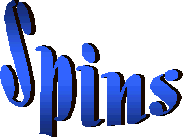

![]()
A stall must occur before a spin can take place. The principle difference that transforms a straight-ahead stall into a spin entry is that one wing stalls more than the other. This usually happens when there is an element of yaw as the stall breaks, and occurs most often when the airplane is in uncoordinated flight. Stalling with crossed controls is a major cause of spins, and usually happens when either too much or not enough rudder is used for existing yawing forces. If an airplane is near the stalling angle of attack, and if more lift is lost from one wing than from the other, that wing will drop more quickly than the other, creating a roll toward the wig with less lift. As this wing drops, its local relative wind will come more from below, further increasing the angle of attack for that wing. Likewise, as the airplane rolls around its center of gravity, the upper wing has a lower local angle of attack, and continues to develop some lift. This situation of unbalanced lift tends to increase as the airplane yaws toward the low wing, accelerating the higher outside wing while slowing the inner, lower wing still more. As with other stalls, the nose drops, and and as inertial forces come into play, the spin usually stabilizes at a steady rate of rotation and descent.
![]()
Incipient Spin: This is the first phase and exists from the time the airplane stalls and rotation starts until the spin is fully developed.
Fully Developed Spin: Exists from the time the angular rotation rates, airspeed, and vertical descent rate are stabilized from one turn to the next.
Spin Recovery: When the anti-spin
forces overcomes the pro-spin forces.
It is crucial that you initiate
recovery from an inadvertent spin as soon as possible, since many airplanes will
not recover from a fully developed spin, and others continue for several turns
before recovery control inputs become effective. The recovery from an
incipient spin normally requires less altitude, and time, than the recovery from
a fully developed spin. Keep in mind that although some characteristics of
a spin are predictable, every airplane spins differently, and an individual
airplane's spin characteristics vary depending on configuration, loading, and
other factors.
![]()
Where the primary goal in recovery from a
straight-ahead stall is to reduce the angle of attack to restore airflow over
the wings, spin recoveries have the additional goal of stopping the
rotation. The complex aerodynamics of spins may dictate vastly different
recovery procedures for different airplanes, so no universal spin recovery
procedure can exist for al airplanes. The recommended recovery procedure
for some airplane is simply to reduce power to idle and let go of the controls,
and others are so reistant to spins that they can be considered
spin-proof. You should be intimately familiar with the procedures in the
POH for the aircraft you will be flying. Here is a general recovery
procedure, but it should not be applied arbitrarily without regard for the
manufacturer's recommendations:
Move the throttles to idle. This minimizes the altitude loss and reduces the potential for a flat spin to develop in most airplanes. It also eliminates possible assymetric thrust multi-engine airplanes. Engine torque and precession can increase the angle of attack or the rate of rotation single-engine airplanes, aggravating the spin.
Neutralize the ailerons. Aileron position is often a contributing factor to flat spins, or to high rotation rates in normal spins.
Apply full rudder against the spin. Spin direction is most reliably determined from the turn coordinator. Do not use the ball in the inclimometer. Its indication are not reliable, and may be affected by its location within the cockpit. For example, in some airplanes, if the inclinometer is on the left side of the cockpit, the ball will move to the left in both left and right spins, and if installed on the right side of the cockpit, the ball will move to the right during a spin in either direction.
Move the elevator control briskly to approximately the neutral position. Some aircraft merely require a relaxation of back pressure, while others require full forward elevator or stabilator pressure.
As rotation stops, indicating the stall has been broken, neutralize the rudder. If you maintain rudder pressure after rotation stops, you could enter a spin in the other direction.
Recover from the resulting dive with gradual back elevator pressure. Pulling too hard could trigger a secondary stall, or worse, could exceed the flight load factor limits and damage the aircraft structure. Conversely, recovering too slowly from the dive could let the airplane exceed airspeed limits, especially in aerodynamically clean airplanes. Avoiding excessive speed buildup in the recovery is another reason for closing the throttle during spin recovery. Add power as you resume normal flight, being careful to observe power and r.p.m. limits.